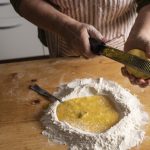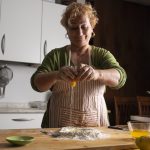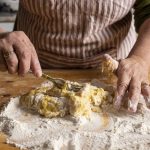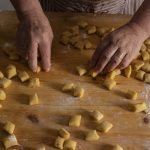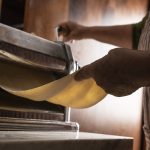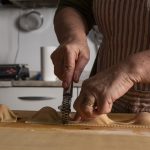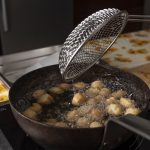Traditional Recipes from Tarquinia
Since ancient times Carnival in Italy has represented a time of freedom, excitement, disguise, and transgression. Every sin is admitted until the beginning of Lent: that is the forty days of fasting, purification, and penance that precede Easter. Carnival is therefore also the time to take advantage of committing sins of gluttony such as eating delicious carnival sweets prepared following the recipes of food blogger, Vittoria Tassoni from Tarquinia.

The tastiest Carnival desserts of this ancient town in central Italy, are castagnole and chiacchiere, prepared with simple ingredients such as flour and eggs. In addition, ravioli filled with ricotta cheese. All these sweets are fried and sprinkled with sugar and Alchermes: a typical Italian liqueur used for desserts. Do not be surprised if you find similar desserts in other parts of Italy. The truth is that every region of the peninsula loves to assume the authorship of the same dish. They sometimes change the names but enhance a particular ingredient to make the recipe unique.
1. Put the flour on a pastry board and make a well in the center.
2. Break the eggs, add the lard and liqueur and knead.
3. Shape into a ball and let it rest for about 30 minutes.
4. Pour the ricotta into a bowl and add the other ingredients,. Mix well, keep in the fridge.
5. Resume the dough and roll out to a medium thickness.
6. Put the ricotta using two spoons to make piles.
7. the ravioli and seal the edge well.
8. Pour peanut oil into a pan and fry the ravioli (being careful when turning them).
9. Drain on a straw paper and sprinkle with powdered sugar.
Collaborative Project by Italian Human Connections and Officina Visiva.
For the stuffing:
- 500 gr of ricotta cheese
- 3 egg yolks
- 150 grams of sugar
- cinnamon to taste
- Alchermes (Italian liqueur used for desserts)
- peanut oil for frying
Method:
1. Put the flour on a pastry board and make a well in the center.
2. Break the eggs, add the lard and liqueur and knead.
3. Shape into a ball and let it rest for about 30 minutes.
4. Pour the ricotta into a bowl and add the other ingredients,. Mix well, keep in the fridge.
5. Resume the dough and roll out to a medium thickness.
6. Put the ricotta using two spoons to make piles.
7. the ravioli and seal the edge well.
8. Pour peanut oil into a pan and fry the ravioli (being careful when turning them).
9. Drain on a straw paper and sprinkle with powdered sugar.
Collaborative Project by Italian Human Connections and Officina Visiva.
[/vc_column_text][/vc_column][/vc_row]
- 400 g of flour 00
- 100 g of semolina flour
- 3 eggs
- 60 grams of lard or butter
- 1 small glass of liqueur
For the stuffing:
- 500 gr of ricotta cheese
- 3 egg yolks
- 150 grams of sugar
- cinnamon to taste
- Alchermes (Italian liqueur used for desserts)
- peanut oil for frying
Method:
1. Put the flour on a pastry board and make a well in the center.
2. Break the eggs, add the lard and liqueur and knead.
3. Shape into a ball and let it rest for about 30 minutes.
4. Pour the ricotta into a bowl and add the other ingredients,. Mix well, keep in the fridge.
5. Resume the dough and roll out to a medium thickness.
6. Put the ricotta using two spoons to make piles.
7. the ravioli and seal the edge well.
8. Pour peanut oil into a pan and fry the ravioli (being careful when turning them).
9. Drain on a straw paper and sprinkle with powdered sugar.
Collaborative Project by Italian Human Connections and Officina Visiva.
[/vc_column_text][/vc_column][/vc_row]
Ingredients for the dough:
- 400 g of flour 00
- 100 g of semolina flour
- 3 eggs
- 60 grams of lard or butter
- 1 small glass of liqueur
For the stuffing:
- 500 gr of ricotta cheese
- 3 egg yolks
- 150 grams of sugar
- cinnamon to taste
- Alchermes (Italian liqueur used for desserts)
- peanut oil for frying
Method:
1. Put the flour on a pastry board and make a well in the center.
2. Break the eggs, add the lard and liqueur and knead.
3. Shape into a ball and let it rest for about 30 minutes.
4. Pour the ricotta into a bowl and add the other ingredients,. Mix well, keep in the fridge.
5. Resume the dough and roll out to a medium thickness.
6. Put the ricotta using two spoons to make piles.
7. the ravioli and seal the edge well.
8. Pour peanut oil into a pan and fry the ravioli (being careful when turning them).
9. Drain on a straw paper and sprinkle with powdered sugar.
Collaborative Project by Italian Human Connections and Officina Visiva.
[/vc_column_text][/vc_column][/vc_row]
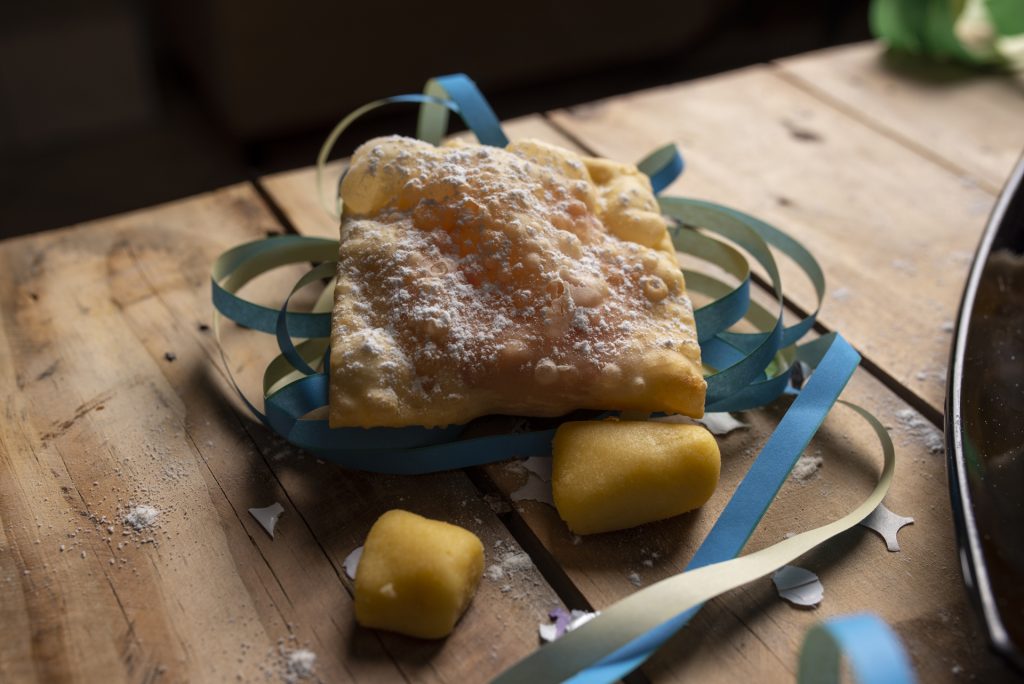
Ingredients for the dough:
- 400 g of flour 00
- 100 g of semolina flour
- 3 eggs
- 60 grams of lard or butter
- 1 small glass of liqueur
For the stuffing:
- 500 gr of ricotta cheese
- 3 egg yolks
- 150 grams of sugar
- cinnamon to taste
- Alchermes (Italian liqueur used for desserts)
- peanut oil for frying
Method:
1. Put the flour on a pastry board and make a well in the center.
2. Break the eggs, add the lard and liqueur and knead.
3. Shape into a ball and let it rest for about 30 minutes.
4. Pour the ricotta into a bowl and add the other ingredients,. Mix well, keep in the fridge.
5. Resume the dough and roll out to a medium thickness.
6. Put the ricotta using two spoons to make piles.
7. the ravioli and seal the edge well.
8. Pour peanut oil into a pan and fry the ravioli (being careful when turning them).
9. Drain on a straw paper and sprinkle with powdered sugar.
Collaborative Project by Italian Human Connections and Officina Visiva.
[/vc_column_text][/vc_column][/vc_row]
Ravioli

Ingredients for the dough:
- 400 g of flour 00
- 100 g of semolina flour
- 3 eggs
- 60 grams of lard or butter
- 1 small glass of liqueur
For the stuffing:
- 500 gr of ricotta cheese
- 3 egg yolks
- 150 grams of sugar
- cinnamon to taste
- Alchermes (Italian liqueur used for desserts)
- peanut oil for frying
Method:
1. Put the flour on a pastry board and make a well in the center.
2. Break the eggs, add the lard and liqueur and knead.
3. Shape into a ball and let it rest for about 30 minutes.
4. Pour the ricotta into a bowl and add the other ingredients,. Mix well, keep in the fridge.
5. Resume the dough and roll out to a medium thickness.
6. Put the ricotta using two spoons to make piles.
7. the ravioli and seal the edge well.
8. Pour peanut oil into a pan and fry the ravioli (being careful when turning them).
9. Drain on a straw paper and sprinkle with powdered sugar.
Collaborative Project by Italian Human Connections and Officina Visiva.
[/vc_column_text][/vc_column][/vc_row]
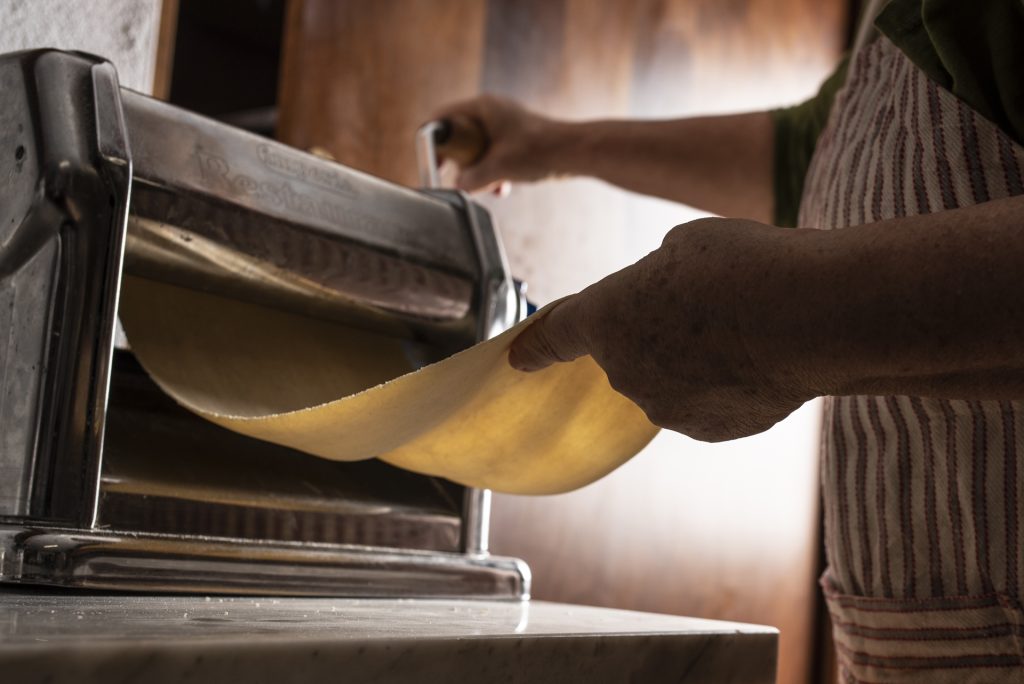
Ingredients:
- 500 g of flour 00
- 60 g of granulated sugar
- 60 g of soft butter
- 175 g of whole eggs
- 4 g of salt
- zest of one lemon
- 50 g of Marsala (fortified wine produced in Sicily)
- Peanut oil or good lard for frying
Method:
1. Sift the flour. Pour it into a bowl and add the sugar and butter. Add the salt to the eggs and beat them with a whisk to mix the yolk with the egg white.
2. Add the grated rind of the lemon and the Marsala. Mix and knead to obtain a firm and smooth dough.
3. Let the dough rest, well covered with film to prevent the surface from drying out.
4. Pull the dough with a rolling pin or with the dough sheeter. The dough must be very thin, almost a sort of veil.
5. Cut out rectangles and fry the chiacchiere in hot oil (about 175-180 ° C). The pastry is so thin that it will only take a few seconds to obtain a beautiful golden color.
6. Drain them with a slotted spoon and then sprinkle them with icing sugar.
Ravioli

Ingredients for the dough:
- 400 g of flour 00
- 100 g of semolina flour
- 3 eggs
- 60 grams of lard or butter
- 1 small glass of liqueur
For the stuffing:
- 500 gr of ricotta cheese
- 3 egg yolks
- 150 grams of sugar
- cinnamon to taste
- Alchermes (Italian liqueur used for desserts)
- peanut oil for frying
Method:
1. Put the flour on a pastry board and make a well in the center.
2. Break the eggs, add the lard and liqueur and knead.
3. Shape into a ball and let it rest for about 30 minutes.
4. Pour the ricotta into a bowl and add the other ingredients,. Mix well, keep in the fridge.
5. Resume the dough and roll out to a medium thickness.
6. Put the ricotta using two spoons to make piles.
7. the ravioli and seal the edge well.
8. Pour peanut oil into a pan and fry the ravioli (being careful when turning them).
9. Drain on a straw paper and sprinkle with powdered sugar.
Collaborative Project by Italian Human Connections and Officina Visiva.
[/vc_column_text][/vc_column][/vc_row]

Ingredients:
- 500 g of flour 00
- 60 g of granulated sugar
- 60 g of soft butter
- 175 g of whole eggs
- 4 g of salt
- zest of one lemon
- 50 g of Marsala (fortified wine produced in Sicily)
- Peanut oil or good lard for frying
Method:
1. Sift the flour. Pour it into a bowl and add the sugar and butter. Add the salt to the eggs and beat them with a whisk to mix the yolk with the egg white.
2. Add the grated rind of the lemon and the Marsala. Mix and knead to obtain a firm and smooth dough.
3. Let the dough rest, well covered with film to prevent the surface from drying out.
4. Pull the dough with a rolling pin or with the dough sheeter. The dough must be very thin, almost a sort of veil.
5. Cut out rectangles and fry the chiacchiere in hot oil (about 175-180 ° C). The pastry is so thin that it will only take a few seconds to obtain a beautiful golden color.
6. Drain them with a slotted spoon and then sprinkle them with icing sugar.
Ravioli

Ingredients for the dough:
- 400 g of flour 00
- 100 g of semolina flour
- 3 eggs
- 60 grams of lard or butter
- 1 small glass of liqueur
For the stuffing:
- 500 gr of ricotta cheese
- 3 egg yolks
- 150 grams of sugar
- cinnamon to taste
- Alchermes (Italian liqueur used for desserts)
- peanut oil for frying
Method:
1. Put the flour on a pastry board and make a well in the center.
2. Break the eggs, add the lard and liqueur and knead.
3. Shape into a ball and let it rest for about 30 minutes.
4. Pour the ricotta into a bowl and add the other ingredients,. Mix well, keep in the fridge.
5. Resume the dough and roll out to a medium thickness.
6. Put the ricotta using two spoons to make piles.
7. the ravioli and seal the edge well.
8. Pour peanut oil into a pan and fry the ravioli (being careful when turning them).
9. Drain on a straw paper and sprinkle with powdered sugar.
Collaborative Project by Italian Human Connections and Officina Visiva.
[/vc_column_text][/vc_column][/vc_row]
Chiacchiere

Ingredients:
- 500 g of flour 00
- 60 g of granulated sugar
- 60 g of soft butter
- 175 g of whole eggs
- 4 g of salt
- zest of one lemon
- 50 g of Marsala (fortified wine produced in Sicily)
- Peanut oil or good lard for frying
Method:
1. Sift the flour. Pour it into a bowl and add the sugar and butter. Add the salt to the eggs and beat them with a whisk to mix the yolk with the egg white.
2. Add the grated rind of the lemon and the Marsala. Mix and knead to obtain a firm and smooth dough.
3. Let the dough rest, well covered with film to prevent the surface from drying out.
4. Pull the dough with a rolling pin or with the dough sheeter. The dough must be very thin, almost a sort of veil.
5. Cut out rectangles and fry the chiacchiere in hot oil (about 175-180 ° C). The pastry is so thin that it will only take a few seconds to obtain a beautiful golden color.
6. Drain them with a slotted spoon and then sprinkle them with icing sugar.
Ravioli

Ingredients for the dough:
- 400 g of flour 00
- 100 g of semolina flour
- 3 eggs
- 60 grams of lard or butter
- 1 small glass of liqueur
For the stuffing:
- 500 gr of ricotta cheese
- 3 egg yolks
- 150 grams of sugar
- cinnamon to taste
- Alchermes (Italian liqueur used for desserts)
- peanut oil for frying
Method:
1. Put the flour on a pastry board and make a well in the center.
2. Break the eggs, add the lard and liqueur and knead.
3. Shape into a ball and let it rest for about 30 minutes.
4. Pour the ricotta into a bowl and add the other ingredients,. Mix well, keep in the fridge.
5. Resume the dough and roll out to a medium thickness.
6. Put the ricotta using two spoons to make piles.
7. the ravioli and seal the edge well.
8. Pour peanut oil into a pan and fry the ravioli (being careful when turning them).
9. Drain on a straw paper and sprinkle with powdered sugar.
Collaborative Project by Italian Human Connections and Officina Visiva.
[/vc_column_text][/vc_column][/vc_row]
- 300 g of flour 00
- 50 g of granulated sugar
- 70 g of melted butter
- 2 eggs
- 1/2 sachet of baking powder
- 1 lemon
- 1 pinch of salt
- Peanut oil
Method:
1.In a bowl, collect the sifted flour with the baking powder. Break the eggs in the center, add the melted butter, rum, sugar, grated lemon zest, and salt. Mix the ingredients, transfer the mixture onto a well-floured pastry board and knead until a smooth and homogeneous dough is obtained.
2. Take a piece of dough and roll it up forming a string of about 1 cm in diameter. Cut into small pieces and shape into balls with your hands. Heat abundant oil in a pan and bring it to a temperature of 170 ° C.
3. Fry a few Castagnole at a time and, as soon as they are golden, drain well and dry them on absorbent kitchen paper. Pass them in granulated sugar or icing sugar and serve immediately.
Chiacchiere

Ingredients:
- 500 g of flour 00
- 60 g of granulated sugar
- 60 g of soft butter
- 175 g of whole eggs
- 4 g of salt
- zest of one lemon
- 50 g of Marsala (fortified wine produced in Sicily)
- Peanut oil or good lard for frying
Method:
1. Sift the flour. Pour it into a bowl and add the sugar and butter. Add the salt to the eggs and beat them with a whisk to mix the yolk with the egg white.
2. Add the grated rind of the lemon and the Marsala. Mix and knead to obtain a firm and smooth dough.
3. Let the dough rest, well covered with film to prevent the surface from drying out.
4. Pull the dough with a rolling pin or with the dough sheeter. The dough must be very thin, almost a sort of veil.
5. Cut out rectangles and fry the chiacchiere in hot oil (about 175-180 ° C). The pastry is so thin that it will only take a few seconds to obtain a beautiful golden color.
6. Drain them with a slotted spoon and then sprinkle them with icing sugar.
Ravioli

Ingredients for the dough:
- 400 g of flour 00
- 100 g of semolina flour
- 3 eggs
- 60 grams of lard or butter
- 1 small glass of liqueur
For the stuffing:
- 500 gr of ricotta cheese
- 3 egg yolks
- 150 grams of sugar
- cinnamon to taste
- Alchermes (Italian liqueur used for desserts)
- peanut oil for frying
Method:
1. Put the flour on a pastry board and make a well in the center.
2. Break the eggs, add the lard and liqueur and knead.
3. Shape into a ball and let it rest for about 30 minutes.
4. Pour the ricotta into a bowl and add the other ingredients,. Mix well, keep in the fridge.
5. Resume the dough and roll out to a medium thickness.
6. Put the ricotta using two spoons to make piles.
7. the ravioli and seal the edge well.
8. Pour peanut oil into a pan and fry the ravioli (being careful when turning them).
9. Drain on a straw paper and sprinkle with powdered sugar.
Collaborative Project by Italian Human Connections and Officina Visiva.
[/vc_column_text][/vc_column][/vc_row]
Ingredients:
- 300 g of flour 00
- 50 g of granulated sugar
- 70 g of melted butter
- 2 eggs
- 1/2 sachet of baking powder
- 1 lemon
- 1 pinch of salt
- Peanut oil
Method:
1.In a bowl, collect the sifted flour with the baking powder. Break the eggs in the center, add the melted butter, rum, sugar, grated lemon zest, and salt. Mix the ingredients, transfer the mixture onto a well-floured pastry board and knead until a smooth and homogeneous dough is obtained.
2. Take a piece of dough and roll it up forming a string of about 1 cm in diameter. Cut into small pieces and shape into balls with your hands. Heat abundant oil in a pan and bring it to a temperature of 170 ° C.
3. Fry a few Castagnole at a time and, as soon as they are golden, drain well and dry them on absorbent kitchen paper. Pass them in granulated sugar or icing sugar and serve immediately.
Chiacchiere

Ingredients:
- 500 g of flour 00
- 60 g of granulated sugar
- 60 g of soft butter
- 175 g of whole eggs
- 4 g of salt
- zest of one lemon
- 50 g of Marsala (fortified wine produced in Sicily)
- Peanut oil or good lard for frying
Method:
1. Sift the flour. Pour it into a bowl and add the sugar and butter. Add the salt to the eggs and beat them with a whisk to mix the yolk with the egg white.
2. Add the grated rind of the lemon and the Marsala. Mix and knead to obtain a firm and smooth dough.
3. Let the dough rest, well covered with film to prevent the surface from drying out.
4. Pull the dough with a rolling pin or with the dough sheeter. The dough must be very thin, almost a sort of veil.
5. Cut out rectangles and fry the chiacchiere in hot oil (about 175-180 ° C). The pastry is so thin that it will only take a few seconds to obtain a beautiful golden color.
6. Drain them with a slotted spoon and then sprinkle them with icing sugar.
Ravioli

Ingredients for the dough:
- 400 g of flour 00
- 100 g of semolina flour
- 3 eggs
- 60 grams of lard or butter
- 1 small glass of liqueur
For the stuffing:
- 500 gr of ricotta cheese
- 3 egg yolks
- 150 grams of sugar
- cinnamon to taste
- Alchermes (Italian liqueur used for desserts)
- peanut oil for frying
Method:
1. Put the flour on a pastry board and make a well in the center.
2. Break the eggs, add the lard and liqueur and knead.
3. Shape into a ball and let it rest for about 30 minutes.
4. Pour the ricotta into a bowl and add the other ingredients,. Mix well, keep in the fridge.
5. Resume the dough and roll out to a medium thickness.
6. Put the ricotta using two spoons to make piles.
7. the ravioli and seal the edge well.
8. Pour peanut oil into a pan and fry the ravioli (being careful when turning them).
9. Drain on a straw paper and sprinkle with powdered sugar.
Collaborative Project by Italian Human Connections and Officina Visiva.
[/vc_column_text][/vc_column][/vc_row]
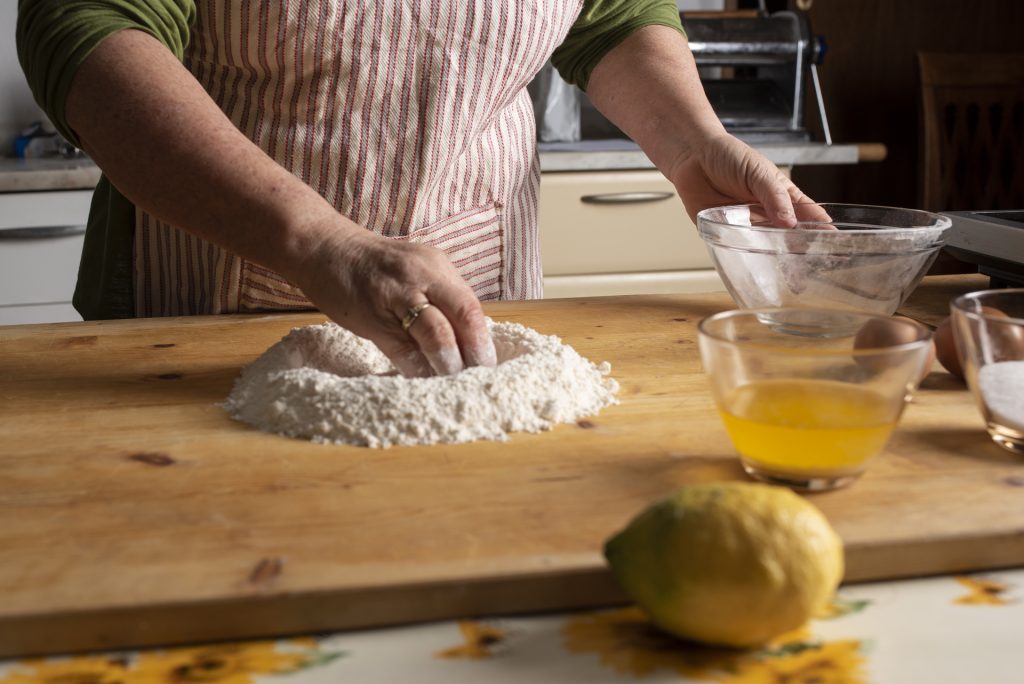
A Plethora of Names
This is why, in other areas of the country, the Tarquinia chiacchiere can also be called: frappe, crostoli, bugie, sfrappole, cenci, galani, and so on. While castagnole becomes tortelli; zeppole or strufoli; ravioli becomes cassateddi, seada; and so on. This plethora of names also remarks the richness of the Italian culinary culture which offers a variety of delicious recipes. Many are also representative of the different holidays of the year. Whatever these sweets are called around Italy, they cannot be missed at Carnival!
Food Blogger to Share Nonna‘s Recepies
Vittoria Tassone became a food blogger perhaps by chance. She opened her website in 2001 only to create a sort of database with traditional recipes to share with people on the Internet. From an early age Vittoria loved cooking with her nonna. Thanks to her, she learned to prepare delicious local dishes with genuine products. Vittoria’s grandmother could neither read nor write so, when she died, left no notes that could pass on her precious cooking recipes. But Vittoria did not give up. In order to save her beloved grandmother’s culinary legacy, she began interviewing all of her old friends in the village. Then, she patiently transcribe each recipe. This work also helped Vittoria take loving care of her grandfather. She was able to continue cooking for him the same dishes he was used to eating with his wife.
The next desire was to share all these notes with the community of Tarquinia. So, she published a recipe book and gave it the name of the most popular local dish: Il Mirandò (boiled beef with tomato and onion) Vivere e mangiare nel borgo vecchio (Living and eating at the old village). Subsequently, she uploaded the content of this book to a website that was not a proper food blog, but a simple collection of online cooking recipes.

Earning a Master’s Degree
Over the years, Vittoria devoted herself more to her website and started studying to become a real food blogger. She graduated from the Hotel Management School and then she obtained a master’s degree in Food and Wine in Rome. Now she is highly regarded as a food blogger and is a frequent guest on television broadcasts. She has become a Chefs’ Alliance of Slow Food and is often committed to important food and wine events.
Many would be also surprised to know that Vittoria managed to combine her studies and passion for cooking with her demanding job as head nurse of surgery! She has two children and three grandchildren. She also has a lot of energy to always put into practice new ideas and projects, such as giving cooking classes for children. Through this project, Vittoria gives them the love that she received from her nonna.
Are you impressed enough with her personality? Wait now to taste her Carnival sweets!
Carnival in Tarquinia
How old is this popular festival? And what connection does it have with the town of Tarquinia?
It seems that the tradition of Carnival in Tuscia dates back to the times of the Etruscans, as depicted in the painted tombs of the necropolis of Tarquinia. There is in fact a particular figure, the so-called Phersu with a long-bearded mask. It is represented dancing and engaged in combat or play activities. Later in Roman times, whole days were organized in honor of the God Saturn. This celebration was filled all sorts of fun, food; and above all, excesses. Everything was allowed and slaves could even act as kings.
So maybe, the common Italian saying, A carnevale ogni scherzo vale! (Anything goes at Carnival!) could be traced back to Roman times. Now as then, Carnival is a time to have fun and play pranks.
Therefore, as many other celebrations, Carnival has Pagan roots. Over the centuries, it evolved into a Christian festival to enjoy the carefree moments and abundance of food: especially sweets before the fasting of Lent. Nowadays, along with sweets and desserts, the Carnival in Tarquinia also brings excitement: floats; parades; masquerade balls; fancy dress costumes; entertainment; music; parties; jokes; and tricks.
However, Tarquinia deserves to be visited all year round! Discover the Etruscan civilization {one of the most advanced of the pre-Roman age) which left a very rich treasure of art, history, and culture. Tarquinia boasts its World Heritage Site designation for its wonderful Necropolis and famous painted tombs. This small town also offers a journey up to the Middle Ages, with its towers, churches, and enchanting city walls. It overlooks the Tyrrhenian Sea, with its long beaches and expanses of blue.
Vittoria’s Tribute to Tarquinia
Vittoria is not only a food blogger who loves her local cuisine and is committed to passing on her grandmother’s cuisine to new generations, she is also a benefactress who has brought value to the Tarquinia community by safeguarding the local culinary tradition and the connection with the past. With her commitment to sharing her nonna‘s recipes, but also in the production of new dishes capable of revisiting the local cuisine, Vittoria manages to pay a tribute to her hometown by enhancing its taste, and food and wine tradition. Nature, history, art, culture, and culinary tradition are the keywords to describe Tarquinia: a unique town to be discovered, and not only at Carnival.
Curiosity
Watch out for a false friend. In Italian, confetti is not what you may think. In fact, confetti for Italians are sugared almond sweets, used for weddings, christenings, or graduation parties. Whereas coriandoli are colored pieces of paper thrown in the air to celebrate carnival. Isn’t that funny?
Have fun and Buon Carnevale!
Enjoy Vittoria Tassoni’s Carnival Recipes!
Castagnole
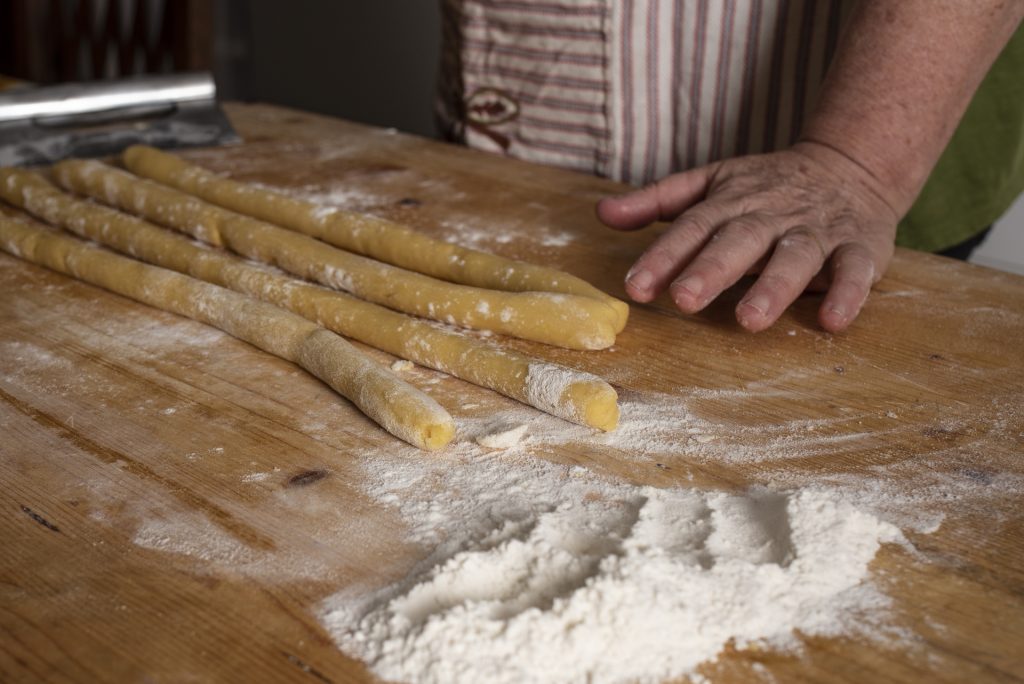
Ingredients:
- 300 g of flour 00
- 50 g of granulated sugar
- 70 g of melted butter
- 2 eggs
- 1/2 sachet of baking powder
- 1 lemon
- 1 pinch of salt
- Peanut oil
Method:
1.In a bowl, collect the sifted flour with the baking powder. Break the eggs in the center, add the melted butter, rum, sugar, grated lemon zest, and salt. Mix the ingredients, transfer the mixture onto a well-floured pastry board and knead until a smooth and homogeneous dough is obtained.
2. Take a piece of dough and roll it up forming a string of about 1 cm in diameter. Cut into small pieces and shape into balls with your hands. Heat abundant oil in a pan and bring it to a temperature of 170 ° C.
3. Fry a few Castagnole at a time and, as soon as they are golden, drain well and dry them on absorbent kitchen paper. Pass them in granulated sugar or icing sugar and serve immediately.
Chiacchiere

Ingredients:
- 500 g of flour 00
- 60 g of granulated sugar
- 60 g of soft butter
- 175 g of whole eggs
- 4 g of salt
- zest of one lemon
- 50 g of Marsala (fortified wine produced in Sicily)
- Peanut oil or good lard for frying
Method:
1. Sift the flour. Pour it into a bowl and add the sugar and butter. Add the salt to the eggs and beat them with a whisk to mix the yolk with the egg white.
2. Add the grated rind of the lemon and the Marsala. Mix and knead to obtain a firm and smooth dough.
3. Let the dough rest, well covered with film to prevent the surface from drying out.
4. Pull the dough with a rolling pin or with the dough sheeter. The dough must be very thin, almost a sort of veil.
5. Cut out rectangles and fry the chiacchiere in hot oil (about 175-180 ° C). The pastry is so thin that it will only take a few seconds to obtain a beautiful golden color.
6. Drain them with a slotted spoon and then sprinkle them with icing sugar.
Ravioli

Ingredients for the dough:
- 400 g of flour 00
- 100 g of semolina flour
- 3 eggs
- 60 grams of lard or butter
- 1 small glass of liqueur
For the stuffing:
- 500 gr of ricotta cheese
- 3 egg yolks
- 150 grams of sugar
- cinnamon to taste
- Alchermes (Italian liqueur used for desserts)
- peanut oil for frying
Method:
1. Put the flour on a pastry board and make a well in the center.
2. Break the eggs, add the lard and liqueur and knead.
3. Shape into a ball and let it rest for about 30 minutes.
4. Pour the ricotta into a bowl and add the other ingredients,. Mix well, keep in the fridge.
5. Resume the dough and roll out to a medium thickness.
6. Put the ricotta using two spoons to make piles.
7. the ravioli and seal the edge well.
8. Pour peanut oil into a pan and fry the ravioli (being careful when turning them).
9. Drain on a straw paper and sprinkle with powdered sugar.
Collaborative Project by Italian Human Connections and Officina Visiva.
[/vc_column_text][/vc_column][/vc_row]



